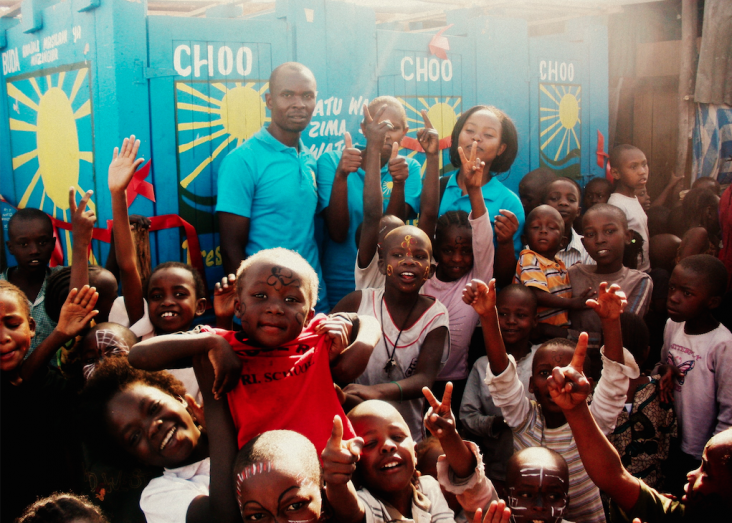
The key to protecting the health of billions may be…worms?
Indeed, USAID is supporting the field-testing of a latrine, dubbed the Tiger Toilet, which is powered by worms. The toilet looks like a typical latrine and provides a normal pour-flush experience for users. But inside its compact tank, Tiger Worms reduce the system’s excrement by more than 80 percent.
The Tiger Toilet pilot is one of a number of solutions that USAID is testing in efforts to improve access to adequate sanitation, arguably one of the greatest threats to public health worldwide. More than 2.5 billion people lack this access, and often practice open defecation as an alternative. This leads to the spread of diseases including cholera, typhoid, and diarrhea, which alone kills more than one child each minute.
Searching for Solutions
While this challenge is not new, USAID has been trying a different approach to solving the sanitation crisis. Recognizing the dearth of effective, affordable, and sustainable solutions as a contributor to the world’s failure to meet the Millennium Development Goal for sanitation, USAID launched a Water and Development Strategy in 2013 with commitments to forging partnerships and embracing science and technology. Part of this strategy aims to bring sustainable improved sanitation services to 6 million people within five years.
“Innovation is critical because sanitation is a challenge we haven’t gotten right by doing things the way we always have,” said Jesse Shapiro, WASH Advisor and Sanitation Focal Point at USAID.
The Strategy bolstered interest in a partnership between USAID’s water experts, USAID’s venture capital-style investment fund, and the Bill & Melinda Gates Foundation. Established in 2011, this $17 million WASH for Life partnership identifies and supports cutting-edge water, sanitation, and hygiene (WASH) solutions through Development Innovation Ventures (DIV), USAID’s open innovation fund.
“Any individual, non-profit, startup, or social enterprise can apply to this competition, any day of the year. If they win, these innovators can tap into USAID and the Gates Foundation’s funding, support and expertise,” said Sarah Burch, a team member at DIV.
In the past three years, the WASH for Life partnership has invested in 13 innovations in 10 countries.
Innovation in Action
The Tiger Toilets are just one example of the partnership’s investments at work. Through an early stage investment of $170,000, the toilets are being piloted in India, Burma, and Uganda in rural and peri-urban environments, and at a displaced persons camp. Initial monitoring has revealed that users find the toilets preferable to traditional latrines. Because the worms break down the solid waste, the toilets emit fewer odors and attract fewer flies than traditional latrines.
“I visited a village in India a couple months ago and spoke to villagers who use the toilets,” said Walter Gibson, CEO of Tiger Toilet developer Bear Valley Ventures, a start-up which specializes in market-led hygiene and sanitation technologies. “The first thing they talked about was the smell and the flies. They said they feel safer going to the toilet now.”
Another pioneering toilet, invented by the startup Sanergy, has also received support from the WASH for Life partnership. Sanergy’s innovation is two-fold: They created toilets that cost just $350 to assemble (traditional community toilets can cost up to $25,000) and developed a system that converts waste from these toilets into fertilizer and electricity-generating biogas. The company franchises the toilets to local youth groups and entrepreneurs, who make up to $1,000 per year by charging small fees for use and selling hygiene products.
During its pilot phase, Sanergy tested 60 toilets in Mukuru, Nairobi. With the additional support from the WASH for Life partnership, Sanergy is building 700 toilets with the hopes of providing sanitation to 70,000 Kenyans and fertilizer and energy to thousands more.
Finding What Works
Innovators like Bear Valley Ventures and Sanergy win funding through the WASH for Life partnership for activities that will either pilot, test, or scale – depending on their previous evidence of impact. By testing gradually, the partnership ensures resources are used judiciously and that innovations are optimized.
“We are able to test innovations at a small scale, so we can see the strengths and areas that need work before USAID commits more resources,” said Ms. Burch.
Once selected, innovators work with the DIV team to test and scale their solutions, while rigorously monitoring and evaluating whether their innovation is meeting the desired impacts and at what costs.
“We are an active partner to our innovators. By leveraging the experience of the venture capitalists, management consultants, and prior-entrepreneurs on the DIV team, we are able to help our innovations grow,” said Ms. Burch.
The WASH for Life partnership continues to source new ideas on a daily basis through the DIV competition, where organizations pitch their innovation in an initial five-page business plan.
Beyond WASH for Life, USAID is now forging more partnerships to support its Water Strategy goals. It recently joined forces with the Government of India to find sanitation solutions there, and it is reaching out to scientists in developing countries to discover new urban sanitation solutions through its Partnerships for Enhanced Engagement in Research (PEER) Program.
Mr. Shapiro said that partnerships like these are instrumental to alleviating the sanitation crisis. “Sanitation is a challenge that we haven’t solved yet, but we are making progress every day,” he said.
C. Zeilberger







Comment
Make a general inquiry or suggest an improvement.